| Plant of the Month |
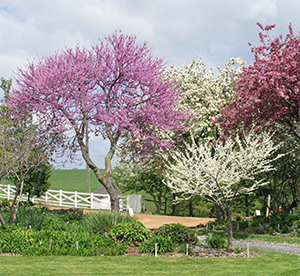 |
| Pink and white blooming redbuds are spectacular in the spring. |
Eastern Redbud
Cercis canadensis
Cercis canadensis, the Eastern Redbud, is without a doubt one of the most beautiful spring blooming American native trees. These are the colorful pink flowering trees that are so often seen in full bloom along highways during the spring. Clusters of showy, deep magenta buds appear on dark gray leafless branches in early spring and open to beautiful rosy pink flowers. The effect in the spring landscape is spectacular.
|
|
|
Flower buds on redbud tree
|
In the Garden
Redbuds are relatively small trees. In the wild, they grow as understory trees, reaching 20'-30' tall but in cultivation, they often don't get that tall. They have a beautiful shape with a short trunk that divides close to the ground giving rise to several upright spreading branches that form a flat to sometimes rounded crown.
Redbuds make outstanding specimen trees but they are particularly striking when planted in small groupings where the mass of brilliant rosy pink flowers really light up the landscape. They are wonderful trees for a woodland garden where their natural beauty and growth form is perfectly suited.
 |
| Cercis canadensis - native redbud |
Attractive foliage
Redbuds have beautiful wide, heart-shaped leaves that usually begin to emerge just after peak flowering. Sometimes during an unusually warm spring, the trees will leaf out early and the foliage and flowers will appear together. The new growth starts out bright green with a reddish tinge and matures to a lovely deep green. In the fall the foliage turns yellow to yellow-green. Some of the named cultivars have a more attractive bright yellow fall color than the species. Green seed pods produced from the flowers mature to a dark brown in October and often persist through the winter.
Culture
Redbuds perform best in full sun to bright shade. They prefer rich, moist, well-drained soils but are very adaptable to a wide range of soil conditions with the exception of very wet or very dry sites. They are hardy to Zone 5 and some may survive in Zone 4 with protection.
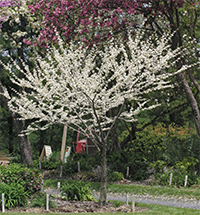 |
| The white blooming Cercis canadensis 'Alba' has pure white blossoms and a beautiful shape. |
Many different cultivars are available. Be sure to talk to a reputable nurseryman to determine the best varieties for your area especially in the colder zones. Andre particularly likes the while blooming form, Cercis canadensis 'Alba'. It is a beautiful tree with pure white flowers.
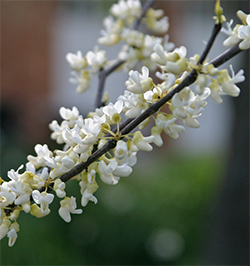 |
| The white blooming redbud is one of Andre's favorites. |
|
Just A Reminder!
|
Don't Forget!!
Rejuvenation Pruning
If you have overgrown shrubs like holly, boxwood, lilac, rhododendron, azalea, or yews, NOW (while they are still dormant) is the time to prune them back HARD. Click for some
video tips.
|
|
| Boxwood pruned hard for rejuvenation |
Evergreen Perennials
Trim back the the winter ravaged foliage of your evergreen perennials such as Helleborus, Epimedium, and Liriope before the new growth begins. Once they begin to grow in the spring, it is difficult and time consuming to trim the old foliage. Click for some video tips.
|
|
|
Cut Liriope back before the new growth begins in spring.
|
|
 |
|
Did You Know?
|
|
|
|
Divide asters in the spring
|
Dividing Plants
in Spring
Early spring is a good time to divide many perennials. February or March before they break dormancy is the best time to divide most
fall blooming perennials like asters,
Helianthus, Chrysanthemums,
Ceratostigma (Plumbago), Japanese anemones, dahlias, and ornamental grasses. Other plants that do better when divided in the spring but after they finish blooming are
Dicentra (Bleeding heart) and
Primula (Primrose).
|
If you enjoy our newsletter, please pass it along to your gardening friends!
|
| Gardening Questions? |
Listen to Andre
on the radio every Saturday morning from 8:00-11:00 on
"In the Garden
with Andre Viette"
|
Viette Discussion Board
|
Having trouble
getting through on
the radio?
Visit our
Discussion Board for answers to your gardening questions. Use the convenient search key to see if we have already addressed your problem!
Don't see the answer? Post your question!
It's EASY, just register
as a member.
Please provide your city and state so we are better able answer your question.
|
|
|
Weekend Gardening Tip
|
| Pruning Needled Evergreen Trees & Shrubs Pruning conifers or needled evergreens incorrectly can be disastrous to the appearance your trees! Two groups of needled evergreens In order to understand how these evergreens should be pruned, it is important to understand how and where they produce new growth. Needled evergreens fall into two basic groups which are determined by their branching pattern; whorl-branched and non-whorled or random branching. Whorl-branched conifers
branch only once a year when new growth occurs in the spring. This results in a whorled growth of branches at the growing tip. In this group, new growth comes from buds at the tips of the branches, buds along the new growth, and from buds at the base of the new growth. Evergreens that fall into this group should not be cut back beyond where there is green growth (or beyond the last whorl) because there are no latent or dormant buds in the bare old wood. If pruned back beyond this point, there will almost certainly be no regrowth on the branch and it will remain a bare stick! Whorl-branched conifers include:
- Abies (Fir)
- Cedrus (Cedar)
- Cryptomeria
- Larix (Larch)
- Picea (Spruce)
- Pinus (Pine)
 |
| Spruce fall into the whorl-branched group. Buds are found on the new growth. |
Random branching conifers produce new growth from buds at the tips of the branches and also from buds that are randomly located along the stems. These evergreens have dormant buds and foliage further back on the stem than the whorled branched species. The result is that this group can be cut back harder and still break into new growth. Still, to be safe, you should not cut back beyond where there is green growth. Non-whorled or random branching conifers include:
- Chamaecyparus (False cypress)
- Cupressus (Cypress)
- Cupressocyparis leylandii (Leyland Cypress)
- Tsuga (Hemlock)
- Juniperus (Juniper)
- Taxus (Yew) *
- Thuja (Arborvitae)
* Yews are an exception to the group because they have dormant buds in the bare wood. These shrubs can be cut back hard similar to the way you can prune boxwood or hollies.
 |
| Juniper fall into the random branching group. Buds are found randomly along branches and at the tips. |
How to prune Whorl-branched conifers These evergreens have a naturally beautiful shape and normally, they require little pruning. Care should be taken when a species or cultivar is chosen to select one that will not outgrow the space you plant it in.
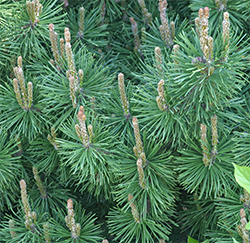 |
| "Candles" on Mugo Pine in April |
Pruning to limit size - Growth can be controlled by pruning if you start when the plant is young. If you wait until the tree has outgrown its space, it will be too late to shorten the growth and have the plant look natural. Pruning candles - The new growing tips on whorl-branched evergreens are called candles. You can control the growth of your tree by pruning the candles.
- If you want to slow the growth a little but still want it to get bigger, remove about 1/2 to 1/3 of the candle when it has elongated to 2"-4" usually in mid to late spring or early summer.
- If you want the tree to remain the same size, remove the entire candle when it gets to be about an inch long.
Other selective pruning should be done in early spring so that the cut ends will heal quicker.
- Dormant buds behind the cuts will begin to grow and will hide the cut ends.
- If pruning is done too late, these buds will remain dormant and no new growth will occur to hide the cut ends.
- NEVER cut back into bare stems! Always cut back to a side branch or a dormant bud so you will get regrowth.
Random Branching Conifers These evergreens can tolerate more pruning than the whorl-branched group because they have more dormant buds along the stem. Pruning cuts can be made almost anywhere along the stem except into bare wood.
- Prune to maintain shape - This is best done in early spring so the new growth covers the cut ends. Selective hand pruning rather than shearing creates a more natural shape.
- Prune to remove wayward branches in early spring. Cut back to a side branch.
- Prune to maintain size - Shear the new growth in summer once the tree or shrub has stopped growing. For prostrate or open growing plants, it is often better to selectively prune individual branches rather than shearing the whole plant.
Other pruning notes:
- For both of these types of conifers, dead, diseased, or damaged branches should be removed as soon as they are noticed regardless of the time of the year. When removing diseased portions, be sure to disinfect shears with a 10% bleach solution between cuts.
- To avoid winter damage, do not prune evergreens in late summer or early fall. The tender new growth that forms will not have time to harden off before cold weather sets in and will freeze and turn brown during the winter.
|
|
More Spring Pruning Tips ...
|
|
Pruning Roses
Hybrid tea roses, floribunda roses, and grandiflora roses
Yearly pruning of hybrid tea roses will keep them blooming at their best. The main pruning should take place in the spring after the threat of cold weather.
- In the spring, when the Forsythia are in full bloom, it is time to prune your hybrid tea roses, floribunda roses, and grandiflora roses.
- Select about 5-6 of the strongest, healthiest, and greenest canes to keep and thin out the remainder of the stems. Cut your strong canes back to 6" - 12" from the ground.
- Cut any winter-damaged stems back to healthy green wood.
- When you are finished, the remaining 5-6 canes should be well spaced and the center of the rose should be fairly open.
Knock Out roses can be pruned in the spring when the Forsythia are in full bloom. These roses are very resilient and durable, so they are relatively easy to care for. There are basically
three different pruning methods that you can use on these beautiful long-blooming roses.
- The first method is to not prune them at all. If you don't prune them, knock out roses (depending on the cultivar) will grow up to 5' tall and about 4'-5' wide. If you follow this option, it might be a good idea to thin them a little every few years to keep them looking nice and blooming well.
- The second method is to cut them back hard and thin out some of the oldest wood every few years in the spring when the forsythia are blooming. They can be pruned back to 18", 24", 26", or even 48" from the ground.
- The third method is to cut them back every year in the spring after the threat of cold weather. You can cut them back hard as above or you can just cut them back enough to shape them they way you want them to look. Thin them out, too, if necessary to improve their appearance and blooming.
Pruning Crape Myrtle
Crape myrtles generally require little pruning if you choose the right variety and right size. They are slow to leaf out in the spring but
once they are breaking dormancy, you can easily see if there is winter damage that needs to be pruned out. This is a great time to prune, thin, and shape up these beautiful trees. First prune out the dead wood and then prune further if needed.
There are two ways to prune crape myrtle:
-
Pruning for tree form
The taller crape myrtle hybrids can usually be trained into tree form by completely removing all but 1-6 of the main stems. As it grows each year, prune out any lower branches that may develop along the main trunks. Because crape myrtle blooms on new wood (current season's growth), even the tree forms bloom more prolifically if they are pruned or thinned in the late spring. Prune out crossing branches and those that are growing into the center of the canopy. If necessary, remove dried flower clusters from the previous season.
- Multi-stemmed shrub form
In the colder areas of Zone 6, crape myrtles may experience some severe die back over the winter. In these colder areas, you may need to treat your crape myrtle as a shrub rather than as a tree. Once they break dormancy in late spring, prune these shrub forms back to about 12" - 18" or sometimes even lower depending on where there is live wood. Your crape myrtle will then flush out in beautiful new, fresh growth that will bloom well and remain compact
- Check out these video tips on pruning crape myrtle.
Pruning Spring Blooming Shrubs
|
|
|
Azalea should be pruned
after flowering in spring
|
Generally, trees and shrubs that flower in the spring form their flower buds in the previous season, usually in the late summer or early fall. These plants flower on "old wood" or growth that was produced the summer before. Because the flower buds are already set on the branches, you should avoid pruning them in the fall, winter, or spring. Shrubs like rhododendron, azalea, quince, lilac, forsythia, viburnum, some hydrangea, and trees like dogwood, redbud, and crabapple fall into this category.
The
best time to prune these spring bloomers is right after they finish blooming. Pruning at this time can range from simple deadheading of spent blooms to heading back branches and thinning to reshape or reduce the size of the plant.
Click for tips on pruning spring blooming shrubs.
Pruning Lavender Plants
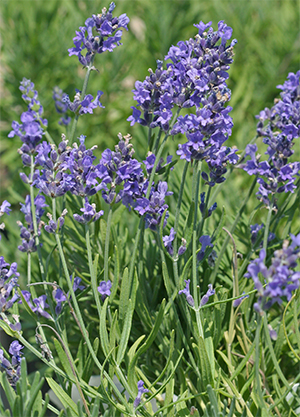 If left unpruned, lavender plants eventually become floppy and sparse. Annual pruning keeps them neater and more compact. This can be accomplished by shearing or by pruning individual stems.
- Prune to remove the old flower stems, removing at least one inch of the leafy growth below the spent flowers.
- In areas with colder winters like we have in the Shenandoah Valley, do this pruning in the early spring.
- In areas with milder winters, they can be pruned right after they finish flowering.
Old, neglected, overgrown lavender plants cannot usually be rejuvenated by more severe pruning; they should be replaced with young vigorous plants. This may be the best course of action if they have been in the ground for many years. You can try pruning them in the spring to see how they respond. If they don't flush out with nice new growth, consider replacing them.
|
From the Viette's Views Blog ...
|
|
|
|
|
Travel with Andre and Claire Viette in 2016!
|
|
|
|
Budapest on the banks of the Danube
|
The Imperial Gardens
and Treasures Tour
September 18 - October 1, 2016
Featuring the Imperial worlds of the
German and Austro-Hungarian Empires
Visit Hungary, Austria,
the Czech Republic, and Germany
Tour highlights include:
Budapest - Enjoy a guided tour of this beautiful city on the Danube; visit a botanical garden; spend a day in the Puszta - land of the Hungarian cowboys and be treated to an equestrian show and gypsy music
Vienna - From Budapest, we will travel up the Danube by hydrofoil boat to Vienna where you will see the famous Lipizzaner Stallions, the
Schönbrunn Gardens, and enjoy a concert of Strauss and Mozart at the
Schönbrunn Palace
|
|
|
Cruising on Berlin's River Spree
|
Prague - We then travel north to Prague by way of the scenic Wachau Valley. Tour Prague, its famous castle, the Charles Bridge, and magnificent gardens. End the day with a three-hour cruise on the Vltava River!
Berlin - On the way to Berlin, we will stop at the city of Dresden. In Berlin, relax on a cruise on the River Spree, enjoy a candlelight dinner and concert at the Charlottenburg palace, and take a walking tour of Berlin. You can even opt to join Andre and Claire on a visit to the largest private botanical garden in Europe.
Andre will give a series of gardening presentations throughout the trip.
Space is limited to 42 persons so this trip will fill up fast!
|
|
|
|
|